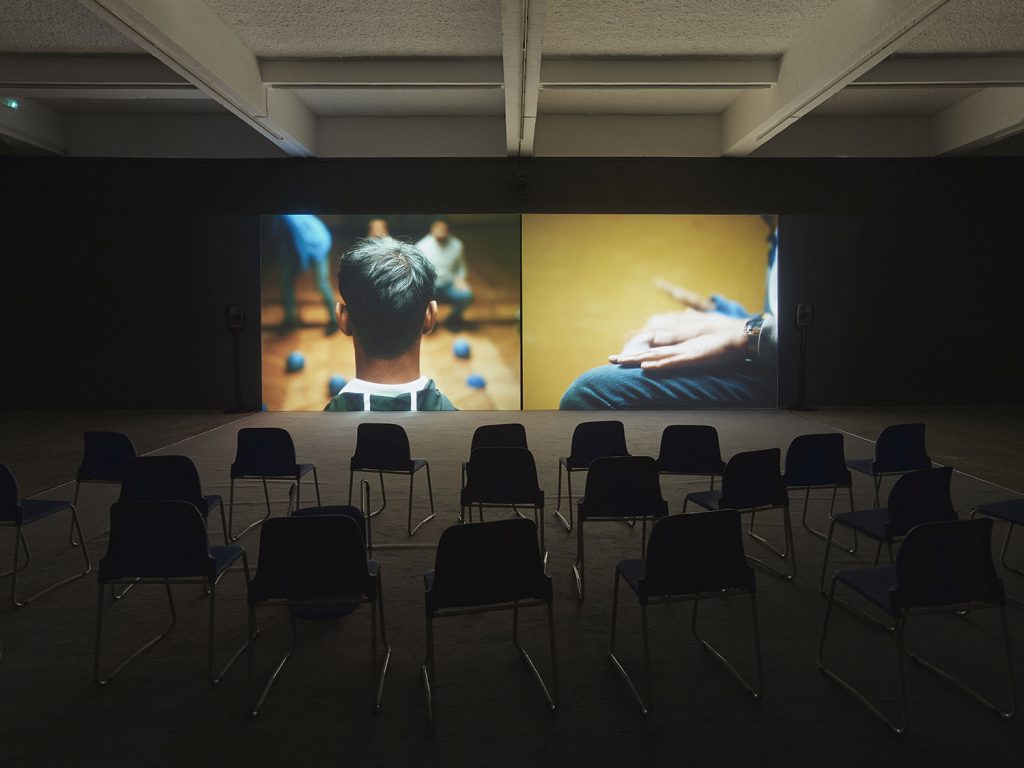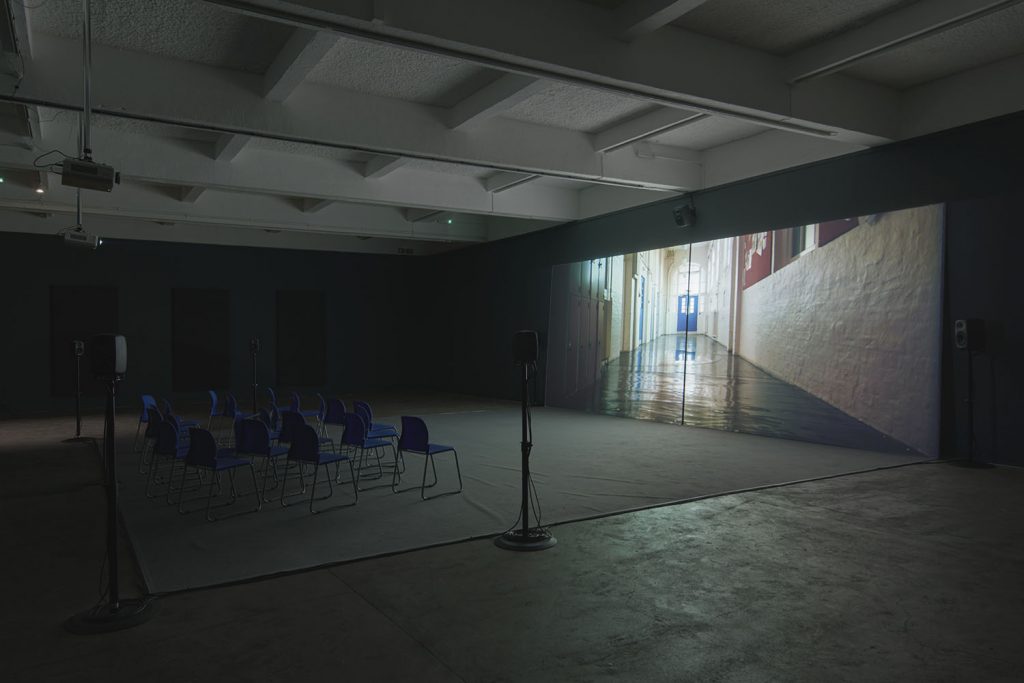Imran Perretta’s the destructors at the Chisenhale Gallery is a two-channel video installation tapping into issues of religion, race and masculinity. Showing from January 16 to April 5, the film uses the exhibition of Shadwell Centre in East London to posit a localism to the multiple pressures of post-9/11 Islamophobia, Asian masculinity, and the withering of public services under austerity.

The titular film itself is largely framed around a poetic monologue that a number of actors recite. The back of their heads are constantly lingered on, being pulled in and out of focus, while they narrate their physical and social surroundings offering both a personal and collective account. These surroundings consist of the everyday violence they experience as constantly surveilled and marginalised people, as well as reflecting on the gendered registers that often stifle the expression of suffering and vulnerability. As ‘the destructors’ progresses, smoke seeps through the community space to a soundtrack of ominous ambience signalling a deteriorating state of affairs, one embedded in the very infrastructures of any sustained social project. The actors are found sitting on ledges, chairs, against walls throughout the dilapidated building as stark visual reminders of those inhabiting marginalisation and neglect. The gallery itself is laid with carpet and school chairs, reflecting those found in the film and offering a ‘nostalgic familiar’, which nonetheless feels awkward in the presence of the ensuing visuals.
Perhaps the most interesting constituent of the ‘the destructors’, and certainly its driving force, is the script that narrates the work. Doubling as both monologue and poetry the viewer is constantly flitting between an embodied figuration and an abstracted syntactical turn. Words rifle: “the scraps / of this diseased imaginary / lumpen, / unctuous / laced with white fury”. Deeply confessional while attentive to diction, this poetic play lends itself to an absolute immersion into the depths of the psyche and cinematic bliss. The finesse of the aesthetic production works within and against the suffering on show. On reflection, an uneasiness with the pessimism engendered is offset by the linguistic force that Perretta channels through the actors Ramzan Miah, Tharek Ali, Islar Abdur-Rahman and Zishan Asfar.

The focus on the locality of East London, not too far from the Chisenhale itself, serves to highlight the enmeshment of how identity is distributed across urban architectures. The presence of the Asian/muslim/brown male within the dilapidated community centre serves a statement of intent. Perretta is both documenting a social reality of political and economic neglect, and generating expression through those conditions. Similarly, in hiding the actor’s faces, the audience is drawn into a space of racialised self-effacement that is spun into a question of filmic frame, perhaps reflecting strategies of opacity under the pressures of surveillance. It really raises questions of how the concrete—literally in this case—offers a line of flight for creative expression and thought, or if it operates purely a space of suffering and deterioration.
Part of the difficulty with the destructors exhibition is whether the work can expand itself out of a presentist approach to the cultures of surveillance and class warfare that austerity represents. Or, to put a different way, it asks, are discourses around Islamophobia and ‘brownness’ able to access and invoke longer aesthetic and cultural histories not reducible to contemporary violences? The reference to Graham Green’s 1954 short story of the same name draws through a lineage of social dissatisfaction and subcultural strains of resistance. In that sense, Perretta is perhaps accessing a gothic undertone where the black smoke lingers ambivalently. As a joint commission alongside Bristol’s Spike Island, Manchester’s Whitworth and Gateshead’s BALTIC CCA, there may be a limitation in making a work legible in a larger discourse that ends up flattening much of the rhetoric around the marginalisation of Muslim communities. Here, 9/11 is understood as the founding violence of current forms of racism, neglecting longer histories of coloniality and Asian Muslim presence within Britain.This perhaps stymies the possibility to linger on the ephemerality of the work.

In the accompanying reading list, compiled in collaboration between Perretta and the Chisenhale, much of it comprises contemporary music alongside literature focusing on racial governance and conflict. From the soulful strains of D’Angelo and Kindness to the future-club sounds of Lorraine James, Ziúr and Jlin, we seem to be implored to think of the sonic as an embodied resistance to racialised and gendered violence that speaks to the work on show. This frame puts the poetic utterances of the destructors into a different lyrical span, offering routes to think performance and expression under more haptic and generative terms beyond governance. A lyricism, in spite of everything, keeps on.**
Imran Peretta’s the destructors solo exhibition is on at London’s Chisenhale Gallery, running January 16 to April 5, 2020.













